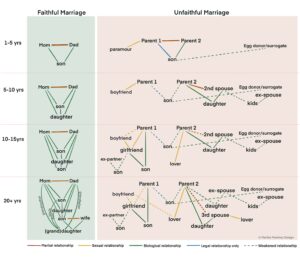Editor’s Note: This essay is the second in a three-part series that, in recognition of Fidelity Month, reflects on the importance of fidelity to God, our families, and our country. You can watch a recording of Public Discourse’s recent webinar on Fidelity Month here.
In the famous story of Penelope from Homer’s Odyssey, we hear about a woman who faithfully waited for her spouse, Odysseus, to return home from war. Despite the attention of more than a hundred suitors, the queen of Ithaca employs diplomacy and cunning to defer their attentions for twenty years, symbolically weaving and reweaving a burial shroud to buy her time. Not until she could confirm that Odysseus had died was she willing to entertain the idea of remarriage. But what about Odysseus? Was he faithful to her?
It depends on how you look at it. During his arduous ocean journey home, he meets up with two separate seductresses. The first, Circe, uses her magic to charm Odysseus into an intimate relationship as she provides for his every desire. After a year of island comforts, however, he asks her to release him and his crew so they can return home.
The commitment to marriage is often fraught with difficulties and missteps, but what matters is turning things around, healing wounds, and persevering in faithful married love.
Start your day with Public Discourse
Sign up and get our daily essays sent straight to your inbox.Later in the journey, Odysseus is shipwrecked alone on an island, where the obsessed nymph Calypso makes him her amorous prisoner for seven years. She offers Odysseus immortality if he will stay and become her husband forever. But every day, he goes to the shoreline to weep and pray, longing to return to his wife and son. Eventually, Zeus intercedes, and Calypso is forced to free him. He finally makes it home to an epic reunion with Penelope.
My reading of Odysseus’s entanglements is a merciful one, of a hero who falls but ultimately triumphs in the virtue of fidelity. The commitment to marriage is often fraught with difficulties and missteps, but what matters is turning things around, healing wounds, and persevering in faithful married love.
What Is Marital Fidelity?
In modern lingo, marital fidelity is often taken to mean abstaining from sex with anyone other than one’s spouse. However, this involves not only an oversimplification, but a hyper-focus on the sexual aspect of marriage. If marriage is what natural law teaches it is, namely, the union of a man and a woman who 1) give their whole selves to each other: minds, wills, hearts, and bodies; 2) are open to begetting children; 3) agree to a lifelong union; and 4) are exclusive (no side-partners allowed), then it’s not merely about keeping our hands off others, but primarily about being faithful to the whole gift of self being given and received in marriage.
Therefore, we can distinguish among different kinds of infidelity that offend different parts of the marital union. Infidelity of mind and will involves intellectually desiring or wishing for intimacy with another person outside the marriage bond—which includes neglecting to care for one’s spouse, even if no other person is involved. Emotional infidelity, on the other hand, involves misdirecting the heart, allowing one’s feelings to attach to someone else, and/or neglecting our spouse’s emotional needs. And physical infidelity, of course, involves the body and includes succumbing to outside physical, including sexual, acts of affection, and/or neglecting our spouse’s physical-sexual needs.
Essentially, it is possible to cheat not only through sex but in several ways, including by creating intellectual and/or emotional bonds with an opposite-sex friend other than our spouse. Indeed, intellectual and emotional infidelity are often the ladder rungs that lead to the slide down into sexual infidelity. We are body-soul unities, and the sharing of our souls (through our minds and emotions) naturally leads to the sharing of our bodies. So, guarding marital love includes directing our most intimate treasures toward our spouse and warding off alternative appeals, as Penelope did. Or after falling, getting up again, like Odysseus.
It takes concerted effort to avoid indiscretions on all these fronts, but that is where the complete gift of the will matters. When fidelity becomes difficult and a thousand Siren songs are playing in our ears, we tie our will to the mast and take the necessary measures to avoid entrapments. This is made easier by the positive effort to focus on weaving (and reweaving) the two strands of the marriage, man and woman, into one. Committed couples strive toward a more perfect union every day, focusing on daily collaboration, mutual understanding, forbearance, making compromises, patiently bearing each other’s faults, displaying good humor, and making creative sacrifices to add joy to the daily grind. In this way, the lion’s share of romantic energy and attention is already in the right place, and there’s not much of either one left over for others!
Guarding marital love includes directing our most intimate treasures toward our spouse and warding off alternate appeals, like Penelope did. Or after falling, getting up again, like Odysseus.
Modern Criticisms of Marital Fidelity
Clearly, marital fidelity involves a lot of hard work, so it’s reasonable to ask: is it worth it? For decades, we have been hounded with messages that nonmarital sex, easy, no-fault divorce, cohabitation, and same-sex romantic relationships are acceptable, and that we should lighten up on the commitment to faithful marriage as the one and only ideal. Today, we hear new voices calling for society to loosen further, to consider polyamory and support open marriages and polycules, what academics call “consensual nonmonogamous (CNM) relationships.”
Still other (more cantankerous) voices are calling for society to do away with mononormativity altogether (which, like heteronormativity, is used as a term of disparagement—in this case, toward the monogamous ideal). These voices claim it’s discriminatory to put monogamy on a pedestal over and above other romantic relationships.
It’s worth pausing to ask, do they have a point? Or do the cost-benefit scales still tip in favor of fidelity?
Personal Benefits of Marital Fidelity
Social-science research on CNM partnerships is still in its infancy, but the best data to date are not flattering. Participants report lower overall happiness, relationship satisfaction, and sexual satisfaction than monogamous couples. Researchers hypothesize that this is due to minority stress, or the social stigma that still exists toward nonmonogamous partners. If only society were more accepting, the story goes, these groups would experience better outcomes. However, experience-based wisdom suggests other reasons related to the nature of the arrangement itself (and not external social factors). Here are a few of the more obvious hypotheses.
First, a firm marital commitment engenders deep psychological benefits. Once the promise to be faithful, exclusive, and permanent is given, and after some time living that way, couples experience a deep sense of psychological peace. Essentially, they realize they can trust each other. Neither has to worry about whether interest is waning, if the other has his or her eyes on the door, or if there might be a new partner on the side.
Fear of the future is also reduced, as faithful couples have confidence that they won’t be all alone as they face tragedy, illness, old age, and finally, death, especially the longer they stick together through hard times. And fears about parenting and children’s futures are reduced, as mothers can count on the father’s help and fathers can count on the mother’s help. As both sexes pour their unique talents into the parenting enterprise, a great synergy of their strengths gives children the best start in life.
By contrast, consensual nonmonogamy promotes distrust, insecurity, and fear. With no promises to be faithful, exclusive, or permanent, these relationships are unstable and prone to dissolution. Naturally, real or perceived comparisons to other sexual partners will lead to deep insecurities and frail self-esteem. The cluster of relationships will feel unfair; someone will certainly feel less loved and valued than others in the group.
Those in polyamorous relationships will also be more fearful for the future, as the instability inherent in this arrangement makes for precarious long-term planning and investing. In the case of a polycule, high-maintenance group members (the ill, aging, depressed) will be let go to fend on their own.
Challenges multiply when children enter the question. Fights over different perspectives on childcare and discipline will increase, as the revolving door of lovers means more adult opinions have to be managed about what to do with kids. And there is, of course, a heightened risk of novel sexual disease transmission, with the accompanying stress, accusations, and blaming.
Those in polyamorous relationships will also be more fearful for the future, as the instability inherent in this arrangement makes for precarious long-term planning and investing.
Second, permanent marital partnerships accrue material and financial benefits. Faithfully married people are better off financially because they pool their resources, with no sharing with additional romantic partners.
They invest together in their own assets, savings, retirement accounts, and education. This investment includes the manual labor that goes unmonetized—time spent helping with children, chores, and upkeep of other material goods—rather than on outside partners unrelated to the primary home.
Married couples can also sign couple-exclusive contracts with confidence, taking advantage of longer-term opportunities including insurance policies, homeownership, and entrepreneurial endeavors.
Nonmonogamous couples, by contrast, experience greater financial confusion and struggle. Myriad questions about how to handle expenses will bring on stifling decision fatigue. In an open marriage, fights will emerge around who pays for what, lives where, and how much can be spent on new romantic pursuits.
Jealousy seems inevitable as partners spend money on outside relationships, making budgeting an emotional minefield. The instability of polyamorous relationships will preclude much long-term financial strategizing.
Third, faithful marriages generate an ethos of unity. To make the relationship last, spouses must learn to negotiate, compromise, and carve out win-win solutions. Compromise strengthens character and builds emotional resilience. Checks on personal autonomy guarantee growth in selflessness, which leads to more humble service to others, including spouse, children, neighbor, and greater society. Mercy and forbearance are required to hang on, giving rise to more compassionate spouses.
Checks upon personal autonomy guarantee growth in selflessness, which leads to more humble service to others, including spouse, children, neighbor, and greater society.
But open marriages and polycules foment an ethos of division. These relationships give primacy to each individual’s self-actualization through subjective feelings rather than to spousal unity, so tensions and disagreements will more likely to lead to standoffs and exits than to compromises.
Each partner will prefer to release tension outside, on new distractions and abatements, further weakening the primary relationship. Open marriages and polycules will be more susceptible to division and divorce and will bring that spirit of separation to their parenting style, being more willing to separate children from biological parents and established relational bonds. Questions of paternity, fatherly responsibility, and abortion have the potential to sow deep discord and bitter conflict.
Public Benefits of Marital Fidelity
Besides the personal advantages that marital fidelity confers, there are numerous public benefits as well—especially to children and lower income families.
Benefits to children. About 25 percent of the U.S. Population is children, and this sizable portion of our society is also the most vulnerable, dependent on us adults for their well-being. Faithful marriages provide these benefits to kids: 1) A more stable home, meaning greater stability for the child, a greater probability of a lifelong home and family. 2) A safer home, by virtually eliminating the number one risk of child abuse: an unrelated adult male in the home. 3) Higher quality parenting, due to the gender-balanced synergy described above. 4) An anchor for the child’s identity, satisfying the human desire to know and be loved by one’s biological kin. 5) Better educational outcomes, as these kids are statistically more likely to achieve higher grades and degrees, which are correlated with higher earnings later. 6) Increased financial resources, as described above, including inheritance and family-owned assets.
Benefits to the poor and to working-class men. Other vulnerable segments of our society include the poor, and working-class men. Marriage benefits them in several ways: First consider the Success Sequence: 97 percent of millennials who follow the success sequence—that is, they graduate from high school, get a full-time job once their education is completed, and marry before having children—avoid a life of poverty. The power of this sequence, which includes monogamous marriage, can catapult many vulnerable individuals upward.
All the instability, brokenness, and infidelity of nonmonogamous unions will pull and tear communities apart, increasing relational anarchy and human harm, especially toward the most vulnerable: children and the poor.
Marriage is also associated with better mental and physical health for men. Men faithfully married to a woman are less likely to report depression, and they experience higher levels of happiness. Likewise, men do better financially when faithfully married.
All the above benefits of faithful monogamous marriage ripple out to benefit society as a whole (see graphic). They yield more unified and stable families that strengthen the social fabric. Their ethos of unity generates “a web of trust across generations, giving rise to the acquisition of virtues and immense social capital (pp. 9–10 here).” By contrast, all the instability, brokenness, and infidelity of nonmonogamous unions will pull and tear communities apart, increasing relational anarchy and human harm, especially toward the most vulnerable: children and the poor.

Let us acknowledge that, in our wounded world, brokenness is often inevitable. Life happens, and often we cannot live up to the ideal, no matter how much we might try. With compassionate mercy, we can avoid painful judgments of particular people in particular situations. Nonetheless, we cannot give up on fidelity to the marriage ideal, which is the source of human healing, unity, and flourishing. Only when we acknowledge an ideal for what it is—a gold standard by which all other options are calibrated—can we work to shore up less-than-ideal situations to become the best versions of themselves possible.
Those in stable, intact families bear a special responsibility here to reach out to those who are relationally wounded, to share their relationship riches, and to offer apprenticeships in healthy family formation, so as to promote social healing writ large.
Conclusion
Over the past several decades, our civilization has experimented with a number of alternatives to faithful marriage. Yet the evidence is abundant that from a personal as well as a public perspective, we are most likely to flourish when faithful, monogamous, natural-law marriages are plentiful and the norm.
To all our modern marriage heroes, those facing challenging situations and doing all they can to put the needs of their spouse and children before their own self-centered desires, we salute you. Thank you for your national service. You are walking the path of fidelity, which leads to a brighter future for you, your family, and the entire nation.














